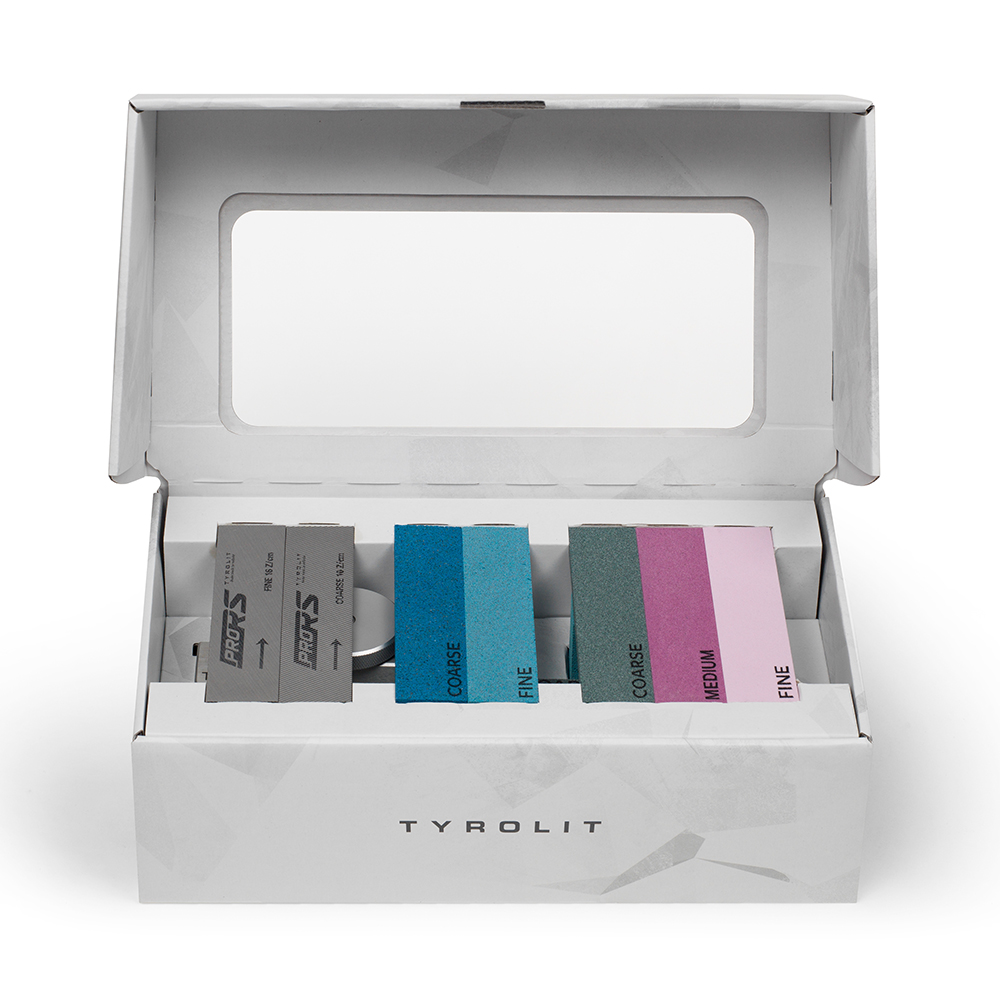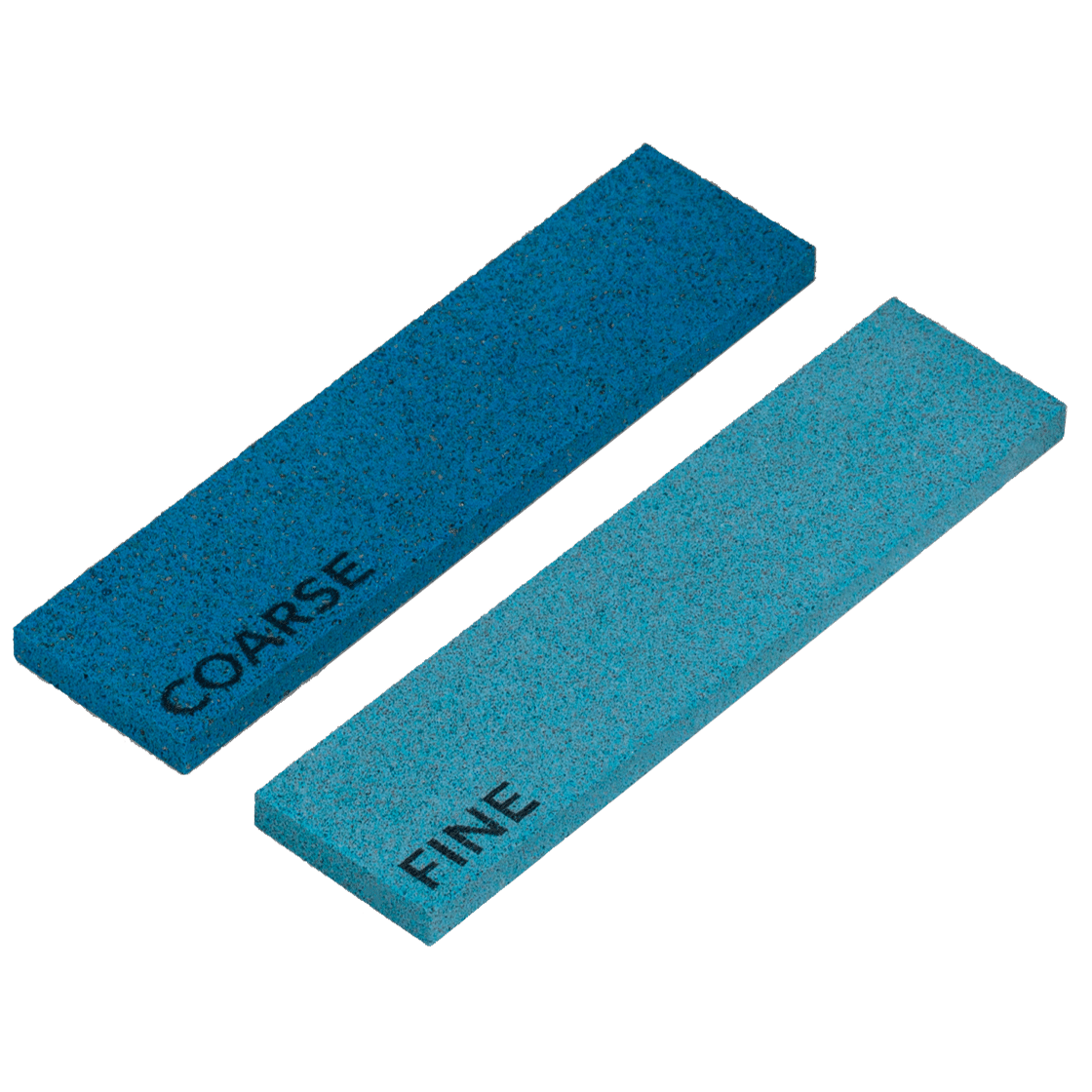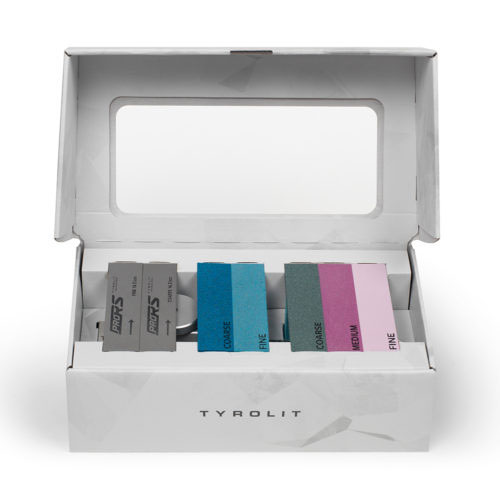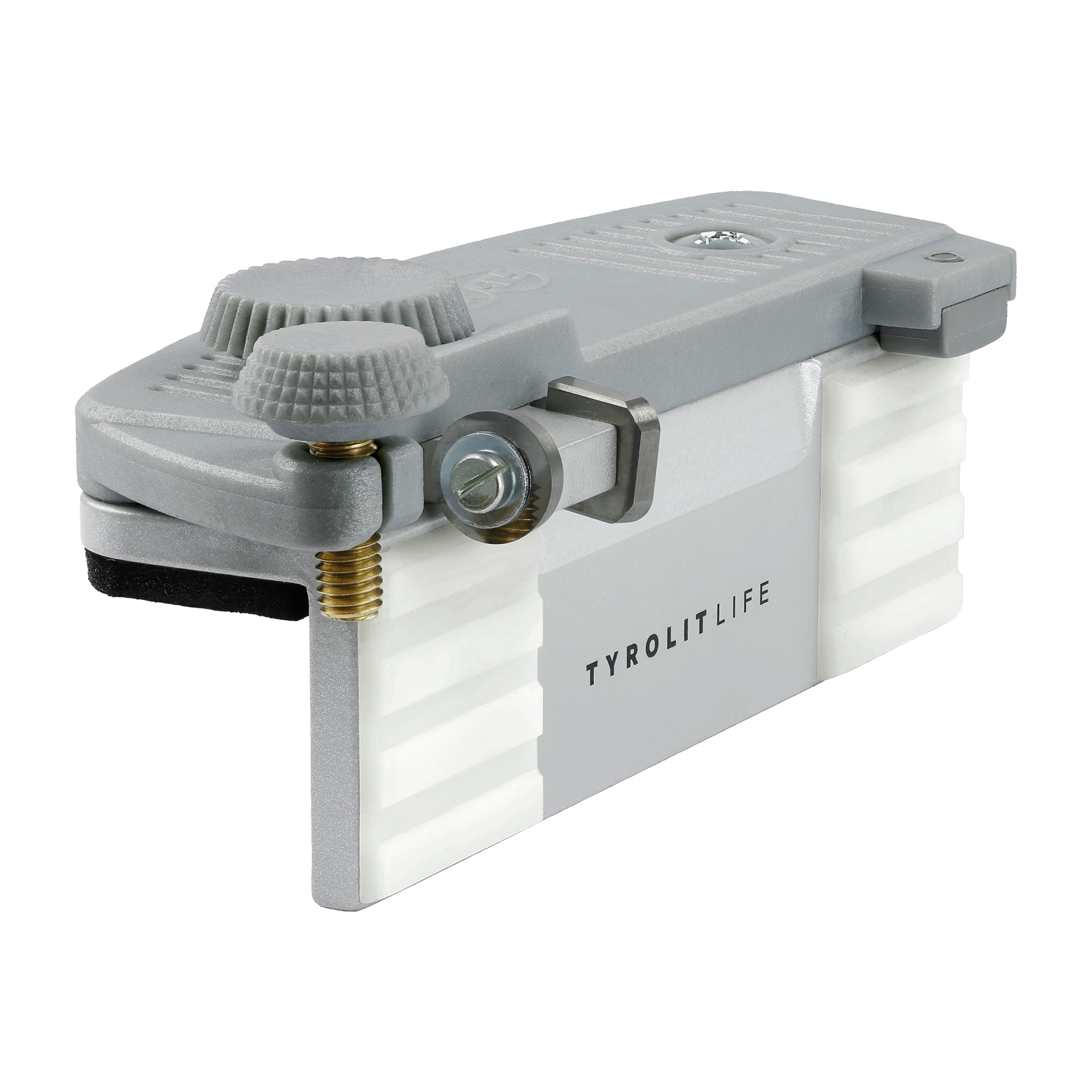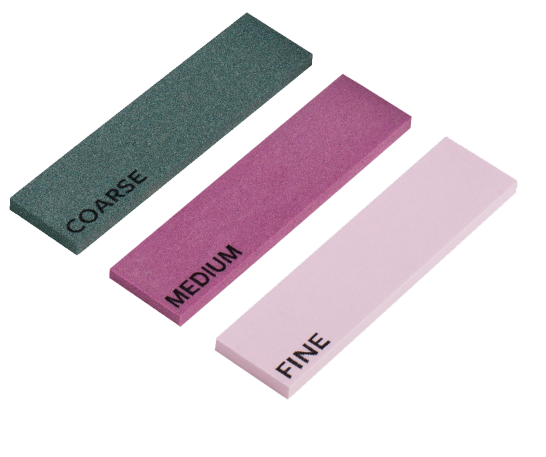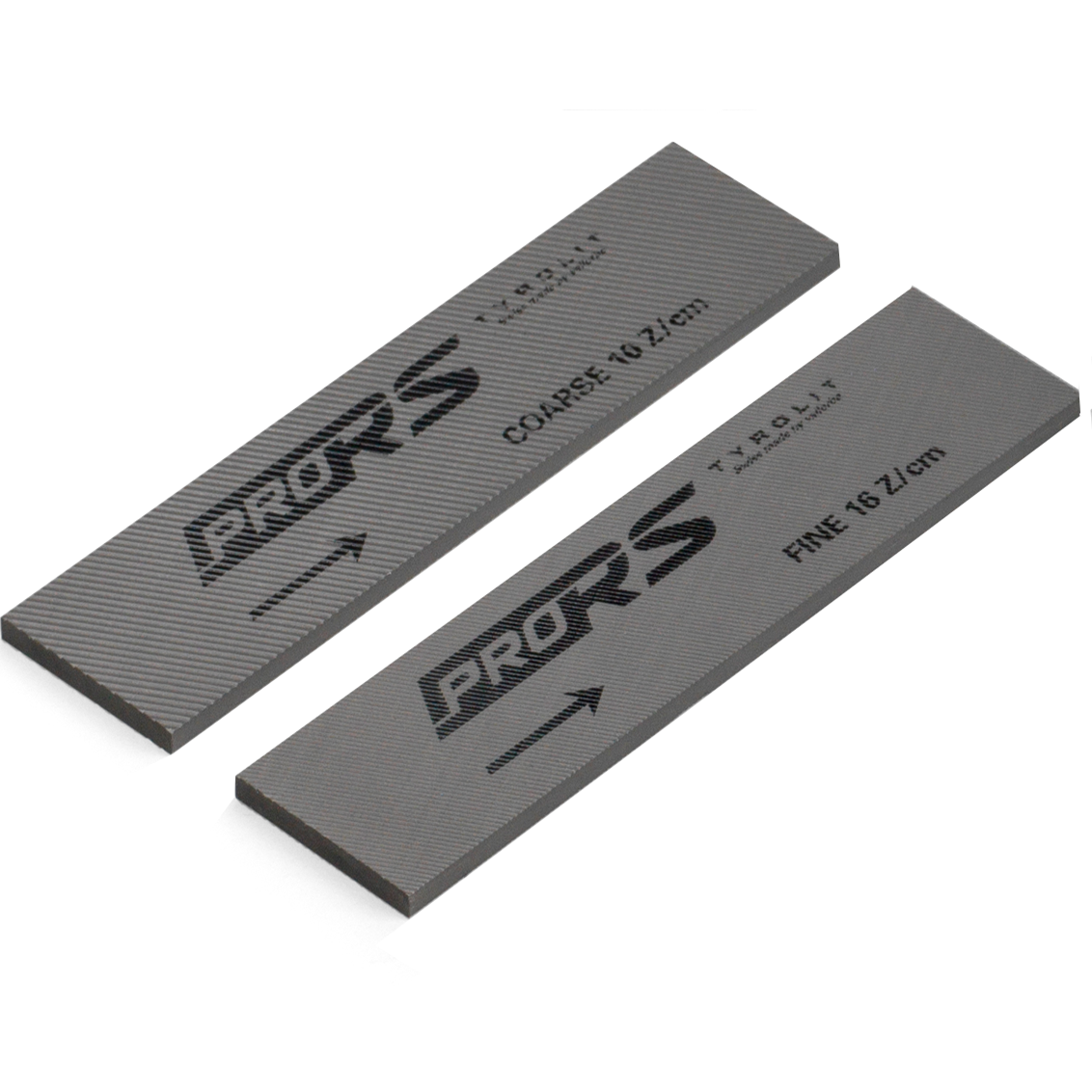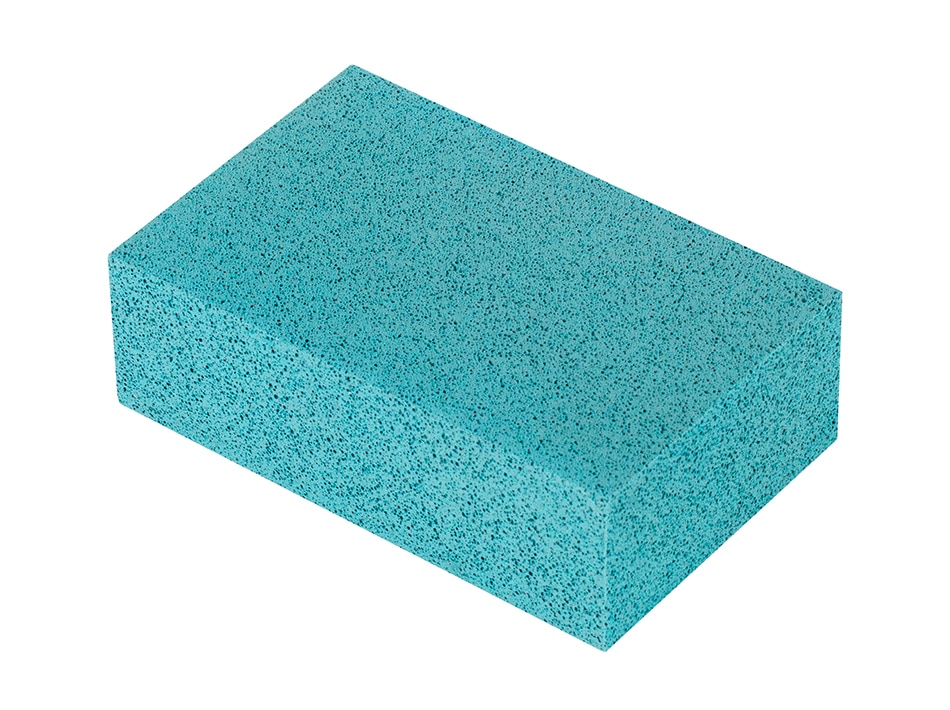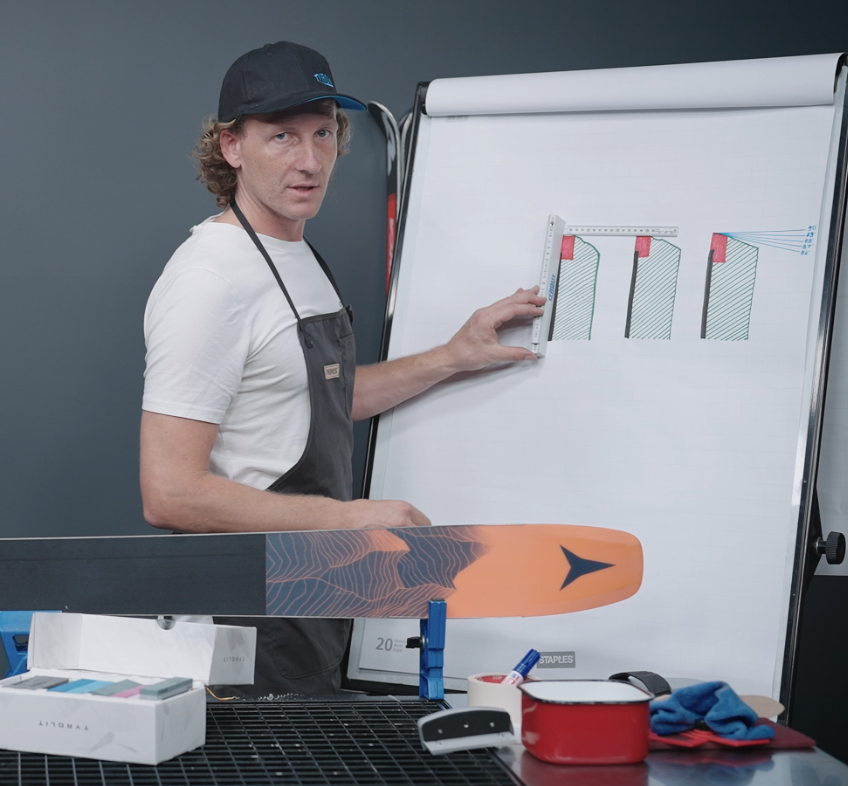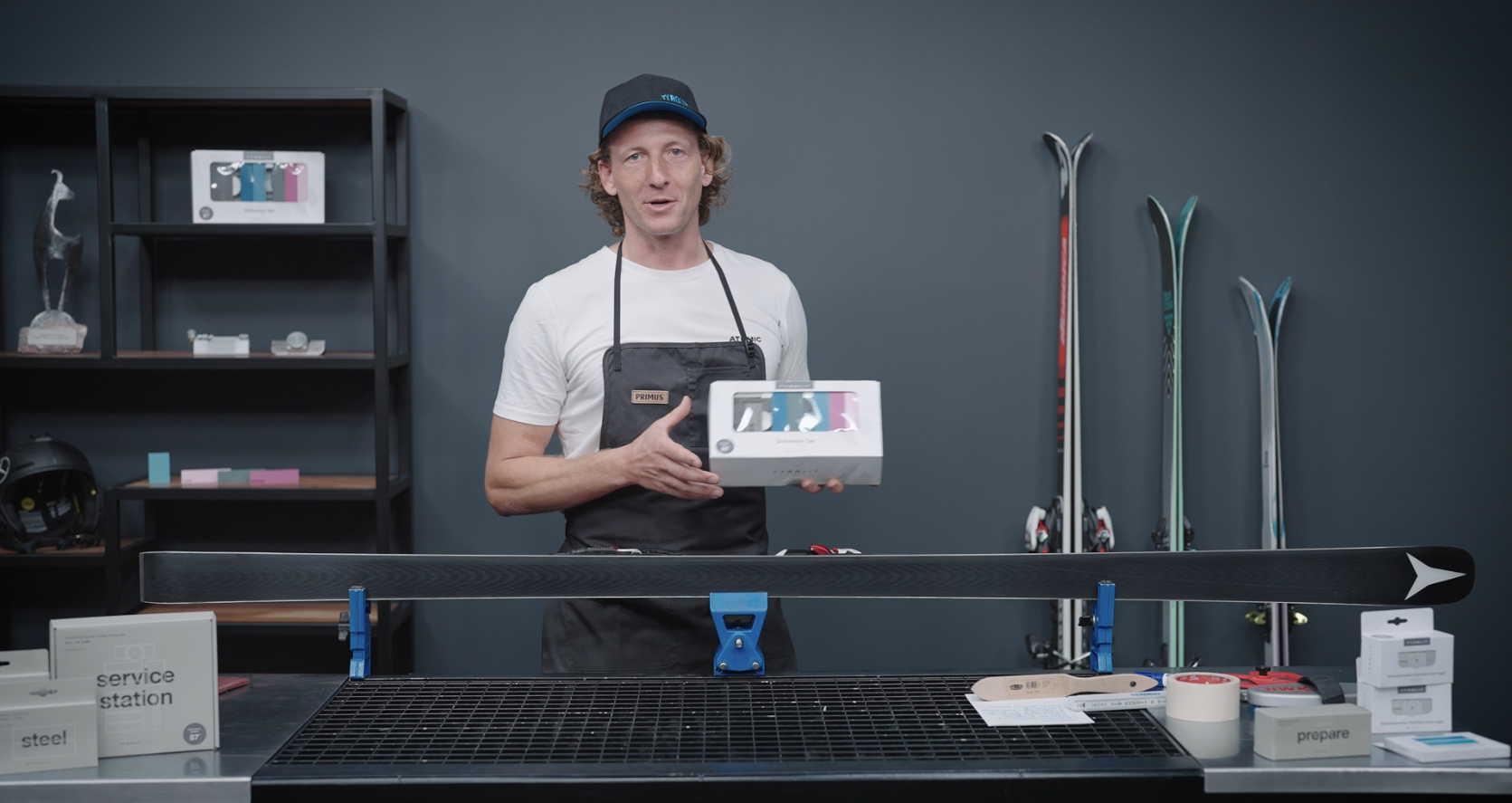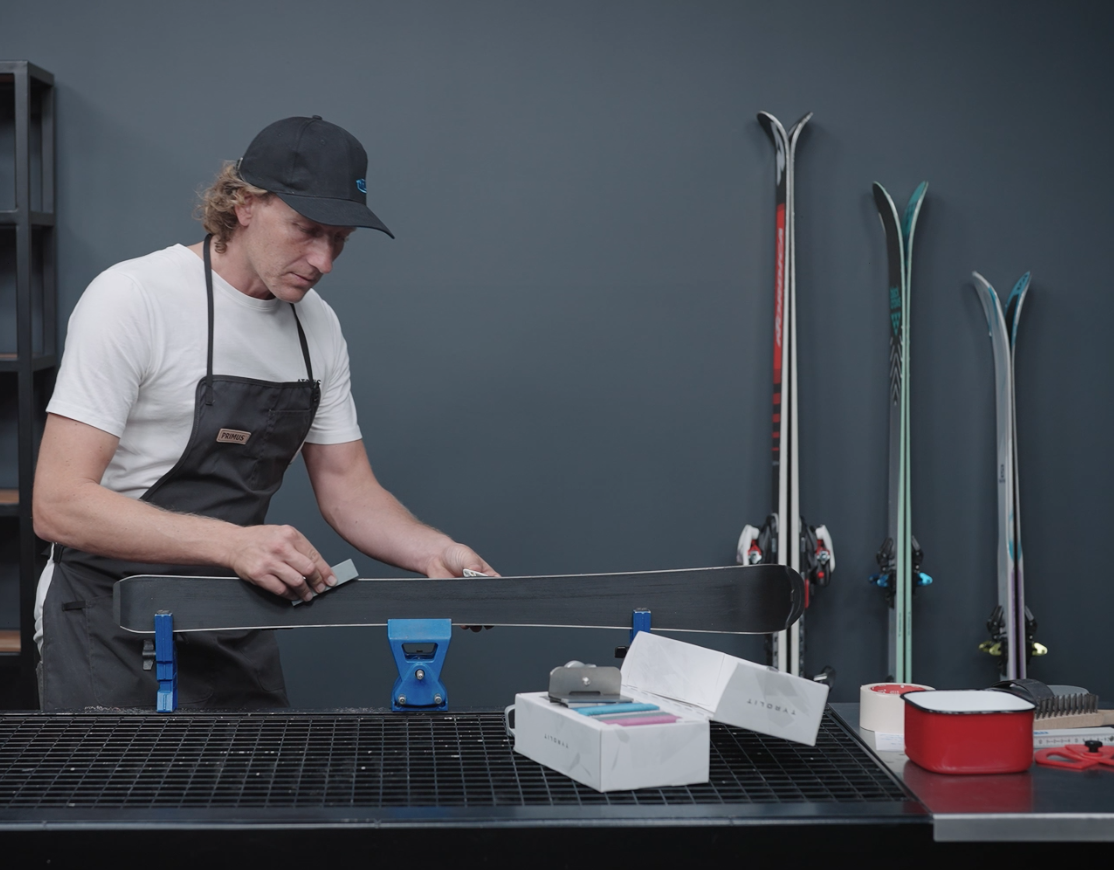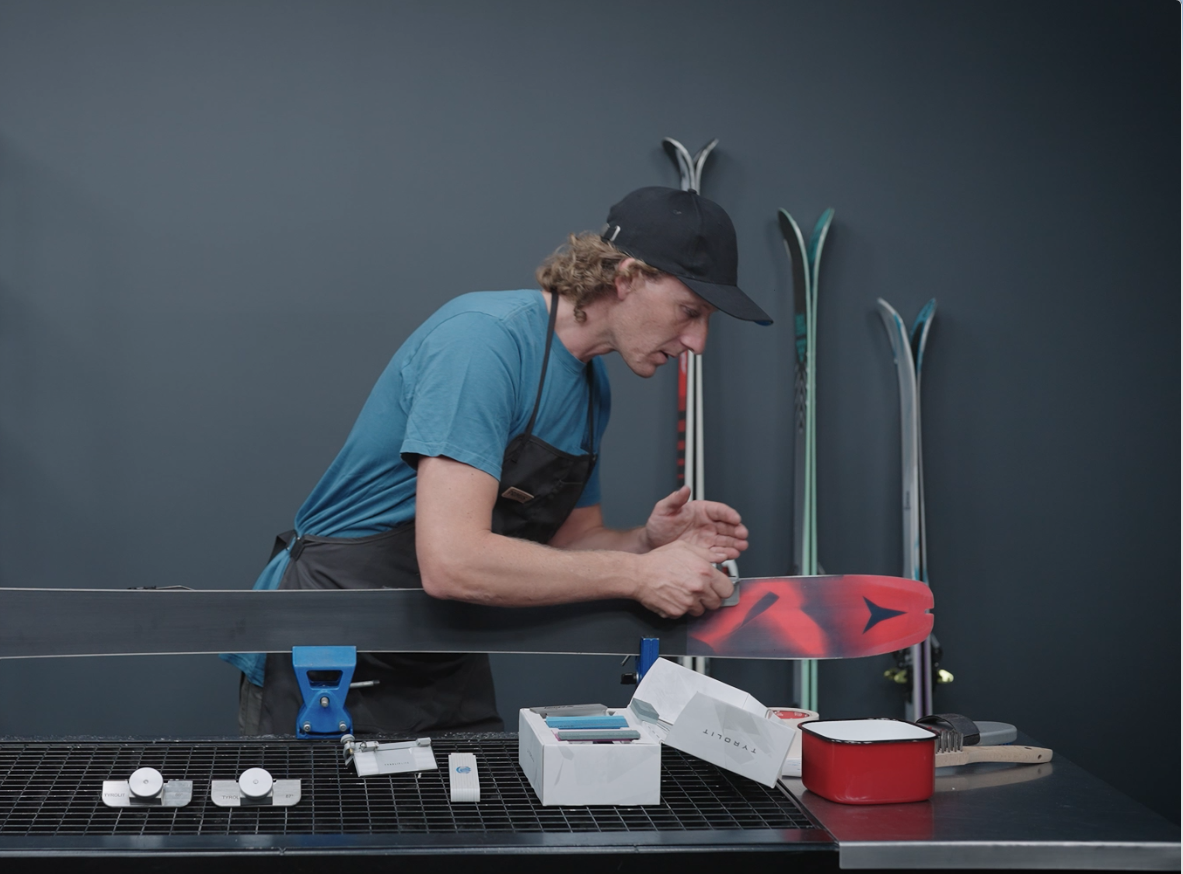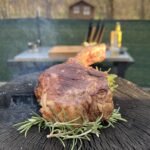Sharpening edges on a snowboard – 7 tips for really good edges

Sharpening snowboard edges – here we offer you a 7-step guide for optimal performance in the park, on the slopes, and in the backcountry. Sharpening your snowboard’s edges is easy to learn for amateurs with the right tools and some preparation. It is important to note right from the start that an edge angle of 88 degrees is recommended for snowboards used in parks, on slopes, and in the backcountry. Only race boarders should consider an edge angle of 87 degrees or even 86 degrees.
The key component is securing your snowboard firmly and securely. There are special devices developed specifically for snowboard edge grinding. Alternatively, you can use a wooden vice. If you only have access to a metal vice, be sure to place a protective rubber or plastic plates between the vice and your snowboard to prevent any damage. Wooden strips can also be utilized to prevent pressure marks on the top of the snowboard and the coating
Clamps are another recommended option. Note that a wider pressure distribution is gentler on the snowboard and its base, and also secures the board better for the grinding work.
If you have a stable workplace at an appropriate height and sufficient light available, you can then also start:
Step 1: Preparing the snowboards
Fold the binding to the board and, if necessary, fix it so that it does not bother you during the work. Firmly clamp the snowboard into a suitable fixture.
Then touch the snowboard edges with your fingers or hold the snowboard up to the light before securing it to identify damage, rust, and critical areas on the edges.
Step 2: Cleaning the snowboard edges
Remove rust from the snowboard edges with an edge rubber or abrasive fleece, both on the side and on the base side.
The first version is clear and accurate; however, for a slight improvement in clarity and fluidity, the final version could be: Carefully smooth out hard spots, bulges, and protruding material, often caused by stones. Ideally, use a combination stone to even out the rough spots, to prevent the edge files from being unnecessarily damaged in step 4.
It is always necessary to alternately work on both the side edge and the base edge!
Step 3: Checking the Sidewall and Using the Sidewall Cutter
Ensure that the snowboard edge to be worked on is exposed and check if the sidewall (made of plastic) above the edge, on the sidewall side of the snowboard, needs to be reduced
If the edges have been sharpened several times and no longer stick out from the sides of the board, we recommend trimming the sidewall with the Tyrolit Life sidewall trimmer to prevent files and grindstones from clogging. This way, you expose the metal edge, allowing you to work on it without grinding the plastic of the sidewall.
Step 4: Coarse filing of the snowboard edges
Clamp the stainless steel files from Tyrolit Life into the stainless steel angle and grind the edge roughly. The chosen angle, be it 86 degrees, 87 degrees or 88 degrees, determines the aggressiveness of the edge. If you change the edge angle, you have to expect more effort. It should be mentioned that most snowboarders choose an edge angle of 88-89 degrees.
Tip: Mark the edge with a felt-tip pen. If the color vanishes uniformly after processing, the edge has been evenly sharpened. Also, remember to always work on the side edge and the base edge alternately!
Step 5: Deburring and rough grinding the edges of your snowboard
Now use the softer ceramic files from Tyrolit Life, clamped in the stainless steel angle, to evenly grind and smooth the edge of your snowboard. Check progress by looking at the light and gently touching with your fingers.
Tip: A smooth edge reflects more light, while rough spots in the light appear dull.
Step 6: Fine grinding and polishing the snowboard edges
Remove the fine burr created by sanding with Tyrolit Life's elastic files. Use the stainless steel angle to polish and perfect the snowboard edge, reducing unwanted friction on the edge's gliding surface. Please also ensure to alternately polish both the side edge and the base edge.
Step 7: Expert tip
To minimize the risk of catching an edge or cross-cutting, it is recommended to slightly dull the edges at the nose and tail. For this, you can use an edge rubber, a grinding rubber, a grindstone, or a file. Too sharp an edge at the front of the shovel or at the back of the snowboard makes the board overly sensitive and aggressive in its steering response, which can lead to sudden catching of an edge in glide sections and on flat terrain. And that is very uncomfortable!
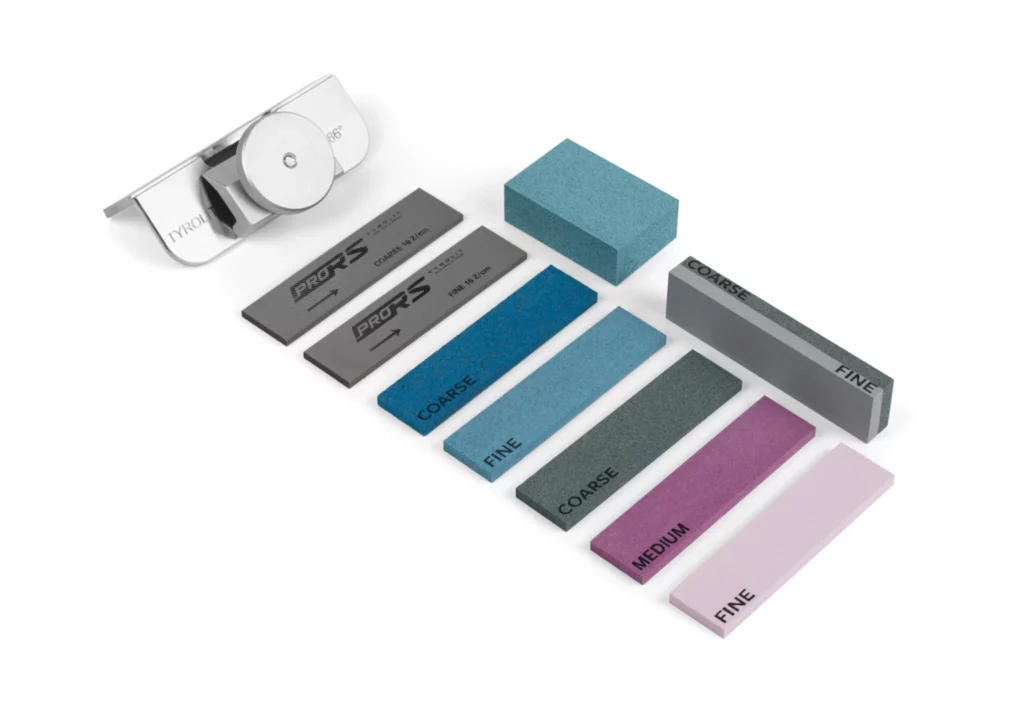
When should you sharpen the edges of your snowboard?
We have now learned how to sharpen the edges of our snowboards. We also understand that a cleanly sharpened edge is essential for smooth and secure turns on any terrain. But when is the ideal time to check and tune your edges?
Here are the key moments when you should inspect your snowboard edges and, if necessary, resharpen them:
Before the snowboarding season
Before you start the new season, it is advisable to check and sharpen your edges. Especially if your snowboard has been stored over the summer and the edges have become rusty, this is important because the rust inhibits the sliding properties.
Edge grinding: For worn or blunt edges
If your snowboard edges are dull or worn and you notice that you're losing edge grip, it's time for a sharpening. Sharp edges are crucial for mastering tight turns and maintaining control.
After intensive snowboarding
After a series of intense snowboarding days, your edges might have taken a beating. Regular sharpening ensures your snowboard remains in top condition.
Sharpening edges for icy slope conditions
Optimal control is essential on icy slopes. When traveling in such conditions, make sure your edges are sharp to maximize adhesion on the ice.
Grind snowboard edges after contact with stones
If you accidentally go over rocks or hard objects and damage your edges, an immediate sharpening is necessary to repair the damage and restore the board's original performance.
After heavy use on rails, boxes, and artificial snow
Rails, boxes, and hard turns on artificial snow heavily wear down snowboard edges. Periodically inspect the edges' condition. On days spent on rails and boxes, it's advisable to slightly dull your edges to prevent snagging or catching. This means avoiding the classic "catching" of the edge on rails or boxes. When returning to kickers or slopes, you should accordingly tune your edges.
In the event of changes in driving behaviour
If you notice that the grip of your edges deteriorates, it may be due to worn or unevenly sharpened edges, or the incorrect edge angle. In that case, inspect and re-sharpen the edges. You'll find it's worthwhile!
If you want to change the edge angle
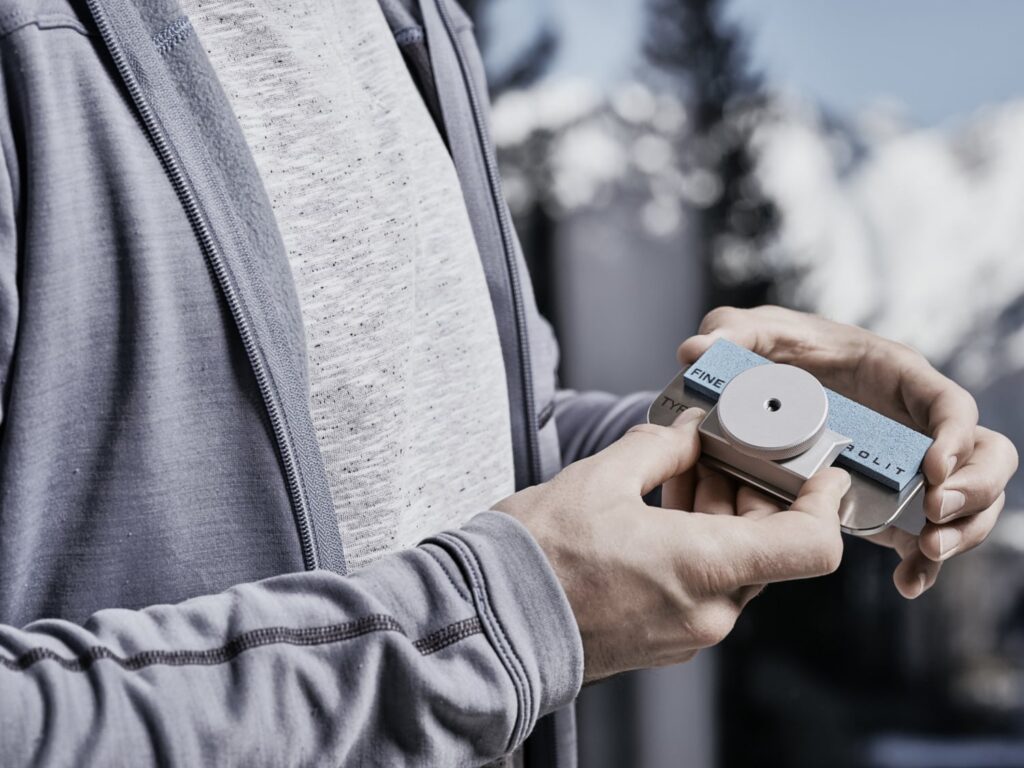
Depending on the snow conditions and your riding style, it may make sense to adjust the edge angle. Precise edge tuning allows you to adapt to different types of snow. If you like to be on the slopes a lot and quickly, experimenting with a sharper edge angle towards 87 degrees or even towards more extreme 86 degrees can pay off!
Before contests or photo shoots
When competing in a snowboard race or major competition, make sure your snowboard edges are perfectly set for maximum performance. Clean, smoothly polished and perfect edges give a very secure feeling, leave nothing to chance for contests and important days!
The Tyrolit Life snowboard edge tuning set in detail
The Tyrolit Life Edge Tuning Kit offers a perfectly matched set of tools to ensure sharp edges. It includes two stainless-steel, three ceramic, and two elastic files, which in combination with the provided stainless-steel angle deliver optimal results. The ceramic combo file, usable without an angle, is perfect for on-the-go, while the handheld edge eraser excels in rust removal, deburring, and cleaning.
Various files are available for precise edge preparation. Stainless steel files are used for preparing snowboard edges, facilitating efficient material removal and the accurate setting of the edge angle. The coarsely toothed "coarse" stainless steel file is ideal for heavily damaged edges, whereas the "fine" 2nd-cut file is suited for refining worn edges
Fine tuning is performed with the three Tyrolit Life ceramic files. These files deburr, smooth, and sharpen the edges in a step-by-step process. By using the grain sizes "coarse", "medium", and "fine", you can tailor the sharpening precisely to the snow conditions and guarantee a high-quality surface finish. The coarse and fine elastic files are ideal for polishing and perfecting the edges, offering an excellent alternative to traditional diamond files. Their elasticity ensures a uniform contact area across all snowboard radii.
The stainless steel angle included in the set allows for precise application of the files and provides various edge angle options of 86, 87, and 88 degrees, depending on the chosen set. All components of the set are also available for individual purchase. The Tyrolit Life edge tuning set, manufactured in Tyrol, ensures a perfect grip through accurate edge preparation.
New in the edge tuning assortment: The Sidewall Stripper
The Tyrolit Life Sidewall Stripper or Sidewall Cutter for skis and snowboards is an indispensable tool for DIY edge tuners. It enables precise stripping of the sidewall, essential for accurate filing work on the steel edge. This premium product can be perfectly combined with the edge tuning sets and offers the following features:
- A depth stop via a brass set screw.
- Two cutting blades with different radii for versatile applications.
- Premium quality for reliable results.
Have fun sharpening your edges and even more fun on the slope, in the park, or in the backcountry!
If you liked this post, our 7-step guide to sharpening ski edges might also interest you here!
These posts with videos might interest you:
Grinding edges on freeride skis
For freeride skiers and their ski edges, special conditions apply. Sharpening the edges is crucial for maintaining control in the depths of untouched terrain. Ex-ski racer and freeride pro Matthias “Hauni” Haunholder explains exactly how it’s done.
Grinding edges of freeride skis: grinding edges of freeride skis
Grinding edges on racing skis
For racing skiers and their high-performance racing skis, grinding the edges of the skis is crucial. Ex-ski racer and freeride professional Matthias "Hauni" Haunholder gives insightful tips and tricks in this video!
Edge Tuning for Racing Skis: Sharpening Racing Ski Edges
Grinding edges on children’s skis
Ski edges for children's skis should be sharpened before the ski season to ensure they function properly and provide the child with safety and edge grip. Ex-ski racer and freeride professional Matthias "Hauni" Haunholder offers insightful tips and tricks in this video.
How to Sharpen Edges on Children's Skis: Sharpening Children's Ski Edges
Sharpening edges on touring skis
For tourers and their touring skis, well-sharpened edges are crucial. Ex-ski racer and freeride professional Matthias "Hauni" Haunholder provides insightful tips and tricks in this video.
Touring Ski Edge Grinding: Grinding Edges on Touring Skis
FAQs on Sharpening Snowboard Edges
Why is sharpening the snowboard edges important?
How often should I sharpen my snowboard edges?
Can I sharpen my snowboard edges myself?
What tool do I need to grind snowboard edges?
Can I change the edge angle of my snowboard?

